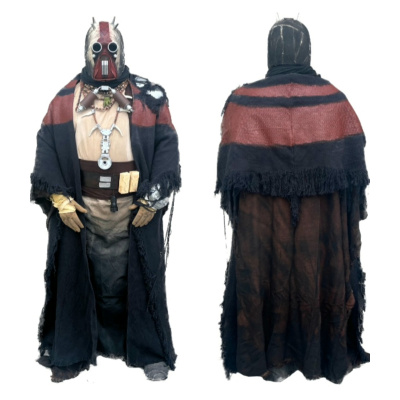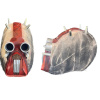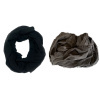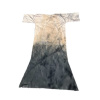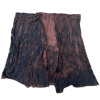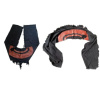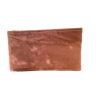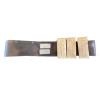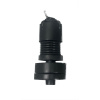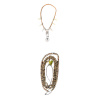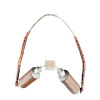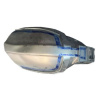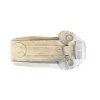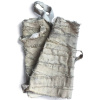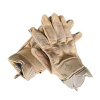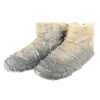Tusken Chieftain - The Book of Boba Fett
Model DZ-28125, Photo by Emma Alford
Description: Tusken Chieftain
Prefix: DZ
Detachment: Krayt Clan
Context: The Book Of Boba Fett, Season 1, Episodes 1, 2, and 3.
The chieftain was the head of a tribe of Tusken Raiders that captured the bounty hunter Boba Fett after his escape from the Sarlacc in the Great Pit of Carkoon. After Fett killed a sand beast, he proved himself to the chief, who accepted him to the tribe.
This Visual Guide has been reviewed by the detachment staff and the LMO team and is certified for use as a minimum approval guideline for GMLs. GMLs are free to approve this costume type.
This is a visual guide used for 501st costume approval, not a how-to for construction. Construction details are found at the costume's Detachment website. Measurements provided here are generalized, and not criteria for approval. All 501st costumes are proportionate to the wearer in terms of size, fit, and scale. During evaluation, both text and images (CRL and Reference) must be considered. When in doubt about a feature of a submitted costume, GMLs should post questions in the Legion forum's DL/GML peer review section.
Required Costume Components
The following costume components are present and appear as described below. For 501st membership only the requirements in black need to be met.
Helmet/Mask
- Head is taller and has a more prominent forehead than other Tusken raiders.
- Helmet is wrapped tightly in frayed, tan colored fabric that is thick enough to be completely opaque.
- Helmet wraps are weathered.
- Horizontal wraps cover the base of the blood spitters and eye stalks and span across the forehead.
- Wraps appear to be continuous, i.e., no loose ends visible.
- The wraps on sides and back of the head are painted a dusty black color, starting at the base of the mouth just below the blood spitters, and angling up diagonally backwards towards the crown of the head and around the base of the neck.
- Black fabric matching the fabric/texture of the tan fabric may be used on the very back of the head.
- Helmet has four spikes protruding from it.
- Spikes are made of metal or painted to look like metal. They are approximately ½ inch (12mm) at the base, ¼ inch (6mm) at the tip, and 1–1¼ inches (25–31.75mm) long.
- Two spikes are evenly positioned in parallel near the top of the helmet and point directly up.
- The other two spikes are evenly positioned slightly above eyebrow level and point evenly outward, away from each other.
- Helmet has two eye stalks which are cylindrical and protrude about 1 inch (25mm) from the face in a forward direction.
- Eye stalks are made of metal or painted to look like metal.
- Eye stalks have some method of obscuring the wearer’s face from the outside such as black mesh.
- Eye stalks are around 1½ inches (38mm) in diameter.
- Eye stalks are positioned with their midpoint at the top of the snout’s arc.
- Helmet has two, two-tier truncated conical “Blood spitters” positioned below the eyes, on either side of the leather snout. The base portion of the blood spitters is roughly the same length as the eye stalks, with the tip extending approximately ½ inch (12mm) longer.
- Blood spitters are made of metal or painted to look like metal.
- Blood spitters are smaller and shorter than ANH, AotC and TM Tuskens, only protruding a little more than 1½ inches (38mm) from the face.
- Blood spitters have a hole in the center.
- Helmet has an elongated leather snout that protrudes only about 1½ inches (38mm) from the face at the top and 2 inches (50mm) at the bottom.
- Snout is loosely shaped like a tall triangle, and is made with several layers of leather.
- Leather snout is darker on the outside, and becomes a lighter brown towards the center, giving it a “burnt” appearance.
- No more than 3 strips of leather are visible on the sides of the snout.
- The snout comes to a dull “point” between the eye stalks.
- The “Bridge” of the snout slopes downward, beginning at the midpoint between the eye stalks and ending evenly with the top of the blood spitters.
- The snout has a metal tooth greeblie in the center that is shaped loosely like an elongated trapezoid that is wider at the top.
- Mouth tooth greeblie consists of four joined strips of metal or metal-like material.
- Strips are slightly wider at the top, and get narrower towards the bottom.
- Mouth "tooth" greeblie has a distinct bend approximately ¾ of the way up, with the top angling in towards the face.
- Greeblie is positioned horizontally between two outward facing strips of leather on the sides, and vertically between two folded pieces of leather that give a bifurcated appearance.
- Helmet has a leather “Crest” or “Mohawk” that starts at the point of the snout, and continues between the eyes and head spikes to just behind the crown of the head.
- Crest consists of rows four downward pointing diamond “arrows” which are layered on top of each other to give a cascading effect. The top point of the top diamond is roughly even with the top set of spikes.
- The bottom of the crest is obscured by a horizontal piece of leather with an inverted, “T” shaped wrinkle. Leather piece is placed above the bridge of the snout and between the eyes.
- The crest is colored a reddish brown, and the lower edges of each diamond are red. The head wraps immediately surrounding it are stained the same color, giving it an airbrushed look.
- The base of the helmet is obscured by a black neck scarf.
Neck Wrapping
- Neck scarf is matte black in color and made of osnaburg, gauze or similar material.
- Obscures the base of the helmet, and tucks underneath the inner robe.
- Approximately the same diameter as the base of the helmet.
Inner Robe
- Inner robe is a basic pattern that has no visible seams on the front. While the sleeves are not visible, they are recommended for ease of use.
- There should be no pleats or darts on the inner robe.
- Robe is long enough to come to the top of the wearer’s foot.
- Inner robe is made of a lightweight, naturally colored osnaburg or linen material.
- The robe is a light tan color at the top, but beginning at the waist, gradually transitions to black or dark grey.
- Inner robe should conceal all skin and cover the bottom of the neck scarf.
- Bottom edge not roll-hemmed and slightly frayed.
Outer Robe
- Outer robe is in the same style as the Tuskens in A New Hope. A rectangular shape that is open in the front, with long, flowing sleeves.
- The robe has no visible seams on the front or back.
- Robe is dark brown in color, but is weathered to look darker in large areas, with some spots being so dark they appear black.
- Outer robe constructed of a thick, heavy, fabric. Linens and other lightweight fabrics are not suitable.
- Sleeve openings are very wide, with at least a 24 inch (600mm) opening and do not have any noticeable fraying.
- Robe hangs to the wearer’s foot, and is frayed at the bottom.
Shawl
- Shawl is draped over the shoulders and arms and is constructed of very coarsely woven, thick fabric, and should show its rough texture very clearly. African mud-cloth is preferred. However, any fabric meeting these requirements is acceptable.
- Weathering and fraying are intense, with some parts having large holes and consisting of little but tangled threads.
- Shawl is black in color, and is weathered to have a dusty appearance.
- The left shoulder of the shawl is torn, revealing the shoulder bell.
- Shawl has two reddish brown stripes which are painted on and give the appearance of caked mud.
- The first stripe is just below the shoulder and is 2–3 inches (50–70mm) in height. Second stripe is much larger and is 1½–2 inches (38–50mm) below the first stripe. Both stripes go completely around the shawl. Shawl is longer in the front, coming to the mid torso of the wearer and continuing along the arms, hanging down to the foot on the inside of the fore-arm, but not hanging below the arm on the back of the sleeves.
- Shawl comes down to the mid back, and is heavily tattered and frayed at the edges.
Waist Sash
- Waist sash worn around the waist and fastens in the back.
- Sash is dark brown, and clearly made of a thick, linty material such as wool.
- Sash is at least 6–6½ inches (152–161mm) in height, and is lain evenly across the wearer’s waist, with very little “scrunching” visible.
Belt
- A thick leather (or leather like material) belt is worn over the waist sash.
- Belt is dark brown in color, with light brown weathering spots in places.
- Belt is constructed of a single piece of leather or leather-like material that shows obvious thickness.
- Belt is approximately 3 inches (76mm) in height.
- Belt has two rectangular greeblies in the center.
- Greeblies are made of metal or painted to look like metal.
- Greeblies are approximately 1 inch by 2 inches (50mm).
- Greeblies are stacked vertically on top of each other on the girth belt.
- Greeblies are attached with leather strips on either side that connect with the girth belt through slots.
- Belt has 3 rectangular pouches on the left side, with about ⅓ of an inch (8mm) separation between them.
- Pouches are made of leather or leather-like material.
- Pouches are slightly taller than the girth belt, and extend past it at the bottom and top.
- Pouches are around 1–1¼ inches (25–35mm) in width and depth, and 3½ inches (88mm) in height.
- Pouches are of a light tan color.
- Pouches have distinct corners, and a separately attached flap that sits in the front for closure.
Belt Greeblie
- There is a cylindrical greeblie that ties onto the girth belt with a leather cord and hangs loosely.
- Greeblie is black and appears to be made of metal.
- Greeblie loosely resembles a flashlight, and has a section at the bottom that is connected with a thin neck.
- Greeblie appears to be threaded, with a section of knurled texture near the top, and 3 “bolts” at the bottom.
- Greeblie is approximately 3 inches (75mm) long and 1 inch (25mm) in diameter.
Necklace
- Two decorative necklaces are worn around the neck, underneath the neck breather.
- The first necklace is made with light brown braided leather bolo cord, and has 6 bone fangs.
- There are 3 fangs on each side of the necklace.
- The fangs connect to the necklace with metal or metal-like loops.
- The fangs are approximately 1½ inches (38mm) each, but can vary.
- In the middle of the necklace is a metal charm
- The charm connects to the necklace with a roughly six-sided, truncated diamond shaped greeblie that has 5 machine screws with hex drive heads.
- Below the diamond is a “tiki” with a loop on each side, and a bifurcated point on each end.
- At the bottom of the necklace is a round greeblie which is wider than the tiki.
- The round greeblie has a hole in the center, and hangs to the top of the belt.
- The second necklace is made with reddish brown beads.
- Necklace appears to consist of at least 3 separate strands.
- Necklace has a small, greenish 3 toed lizard foot in the center.
- Beads are ½ inch (12mm) in diameter and saucer shaped in the front and spherical and smaller towards the sides.
- Each bead is separated by a knot in the cord.
- Beads are made of bone or wood and vary in color, from dark brown to tan.
Neck Breather
- A neck breather is worn around the neck and shoulders, above the necklaces.
- Neck breather has two canisters, each wrapped in dark brown leather.
- The canisters have a cylinder on each end, which give the appearance of dark metal.
- At the end of each cylinder is a flare nut.
- At the center of the neck breather is a metal trapezoidal greeblie with 3 etched lines evenly spaced around the middle of the long axis.
- All the breather components are connected through a thick rigid wire, and bent into a chevron shape.
- The wire contours to the shoulders and bends behind the head.
- The sides and rear of the wire are wrapped in leather cord.
Shoulder Bell
- A shoulder bell is worn on the upper left arm between the outer robe and shawl/top robe, and is exposed by a tear in the shawl.
- Armor appears to be made of metal, with a dark blue stripe down the sides.
- Shoulder contours to the wearer’s arm, and has a rectangular symbol at the top near the neck.
- Although only one shoulder bell is required, something of similar shape may be optionally worn on the right shoulder in order to keep the outfit symmetrical.
Wrist Armor
- Armor resembling what appears in the show should be present on the left wrist.
- The armor covers most of the forearm ending before the elbow.
- The armor is made of metal or painted to look like metal.
- There should be two gutters running along the mid points of the armor, with silver knob in between them near the front, and a cascading disc greeblie at the back.
- At the front, the armor has a raised section that loosely resembles the back of a moth, with a hole on each side of the symmetrical pattern. There are two raised rectangular grill sections on the center of the moth.
- The corners of the armor are shaved off, and are not distinct.
- The armor curves around the arm of the wearer.
Arms
- The arms are wrapped with the same tan fabric as the helmet and boots.
- Wraps cover the base of the gloves, and wrap around the thumb across the wearer’s palm.
- Wraps cover the arm up to the elbow.
- Wraps are weathered.
Gloves
- Gloves are a light tan color, and are of tactical style with a chevron pattern on the index finger.
- First Tactical brand Pro Knuckle gloves in coyote color, or a similar recreation, are accurate.
Boots
- Boots are wrapped in the same coarse fabric as the head and arms, with some strips of black fabric included.
- Boots are weathered heavily.
- Boots come up high enough on the wearer’s leg for the top of the boot to never be seen.
Optional Accessories
Items below are optional costume accessories. These items are not required for approval, but if present appear as described below. If adding in an accessory after initial approval, the item still needs to be submitted to local GML for approval before use.
Staff
- The Chief’s staff matches the design shown on screen.
- The staff is a 1.375 inch (34mm) closet rod made of wood or other suitable material made to look like wood.
- Staff is crowned by a 3 piece spike.
- The top piece has a pointed end and 3 fins
- The bottom and middle pieces also each have 3 fins, and are attached to each other via a coupler with 4 indented lines.
